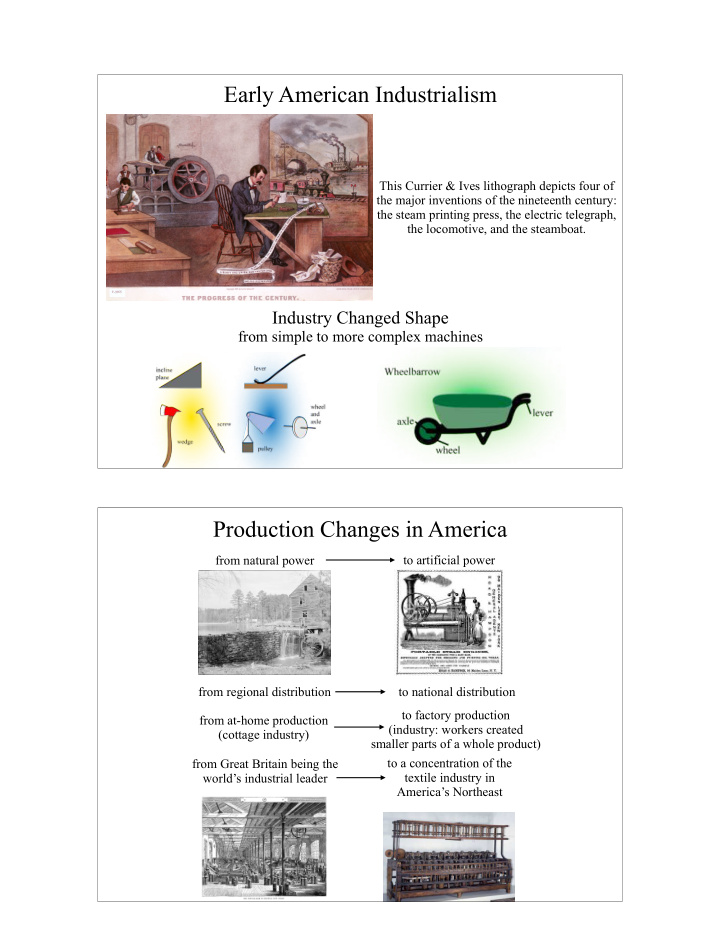



Early American Industrialism This Currier & Ives lithograph depicts four of the major inventions of the nineteenth century: the steam printing press, the electric telegraph, the locomotive, and the steamboat. Industry Changed Shape from simple to more complex machines Production Changes in America to artificial power from natural power from regional distribution to national distribution to factory production from at-home production (industry: workers created (cottage industry) smaller parts of a whole product) to a concentration of the from Great Britain being the textile industry in world’s industrial leader America’s Northeast !
New Inventions - Agriculture Eli Whitney’s cotton gin (1793) 1 worker used to be able to hand clean 1 lb. cotton/day 1 worker can now clean 50 lbs. cotton/day use waterpower = 1,000 lbs./day ! John Deere (1837): steel plow Cyrus McCormick (1834): mechanical reaper New Inventions - Industry Elias Howe: sewing machine (patent granted Sept 10, 1846) “Occupational portrait - woman working at a sewing machine.” Ca. 1853, Library of Congress ! ! Samuel Morse: telegraph key and receiver (1861) ! made transportation and communication faster and ! more efficient ! ON August 17, 1807, a curious Of a sudden, the clouds of smoke crowd of people in New York from the smokestack grew larger, gathered at a boat landing. Tied to the paddle wheels turned, and the the dock was a strange-looking boat, to the astonishment of all, craft. A smokestack rose above the moved. It was “Fulton's Folly,” deck. From the sides of the boat, the Clermont, on her first trip to there stood out queer shaped Albany. paddle wheels.
Samuel Slater: industrial spy and father of the American factory system Slater divided factory work into such simple steps that even children aged four to ten could do it - and did - American children were traditionally put to work around the farm as soon as they could walk. Slater's factory system became a valuable vocation for children at that time, but child labor such as this is not allowed in America today. ! BORN: 1768, Derbyshire, England DIED: 1835, Webster, MA English Factory Worker Samuel Slater has been called the "father of the American factory system." He was born in Derbyshire, England on June 9, 1768. The son of a yeoman farmer, Slater went to work at an early age as an apprentice for the owner of a cotton mill. Eventually rising to the position of superintendent, he became intimately familiar with the mill machines designed by Richard Arkwright, a genius whose other advances included using water power to drive his machines and dividing labor among groups of workers. Sneaky Departure In 1789, Slater emigrated to the United States. He dreamed of making a fortune by helping to build a textile industry. He did so covertly: British law forbade textile workers to share technological information or to leave the country. Slater set foot in New York in late 1789, having memorized the details of Britain's innovative machines. ! Rhode Island Mill With the support of a Quaker merchant, Moses Brown, Slater built America's first water-powered cotton spinning mill in Pawtucket, Rhode Island. By the end of 1790, it was up and running, with workers walking a treadmill to generate power. By 1791, a waterwheel drove the machinery that carded and spun cotton into thread. ! America's Industrial Revolution Slater employed families, including children, to live and work at the mill site. He quickly attracted workers. In 1803, Slater and his brother built a mill village they called Slatersville, also in Rhode Island. It included a large, modern mill, tenement houses for its workers, and a company store - a small pocket of industry, a ready-made rural village. Slater's factory system became known as the Rhode Island System. It was soon imitated - and improved upon by innovators like Francis Cabot Lowell - throughout New England. Slater died in 1835. Textile Industry Emerges ! the North had many swift-flowing streams ! the textile industry centered around these hydropower sources !
Recommend
More recommend